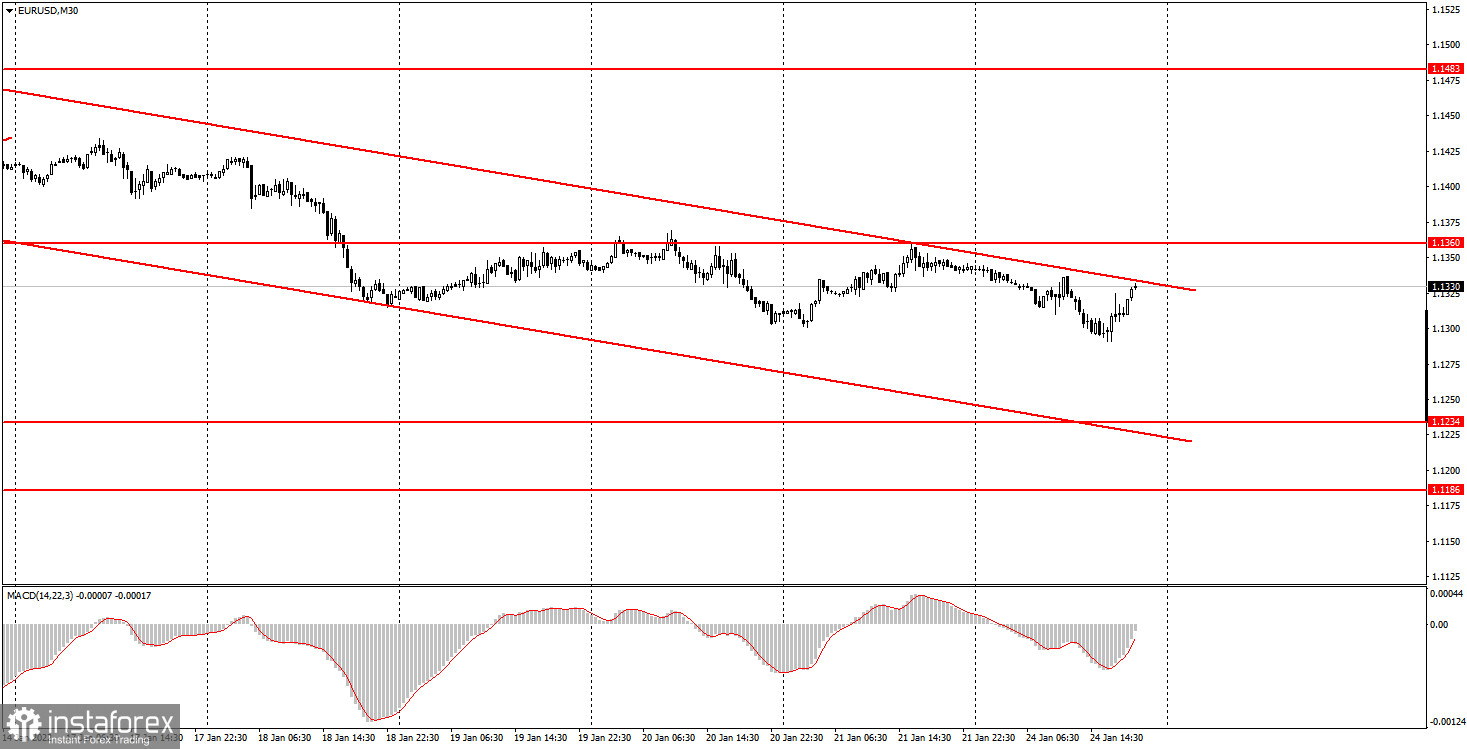Analyzing trades on Monday
EUR/USD on 30M chart

The EUR/USD pair was trading very slowly on Monday. Although this was not a typical flat movement, the volatility was still quite low. In the course of the session, bears tried to take the initiative but bulls pushed the pair up later in the day. So, the pair closed the session at almost the same level where it started. On Monday, several macroeconomic reports both in the eurozone and in the US were published. Beginners should have paid attention to them. As was mentioned in the previous article, a sharp drop in economic indicators from their previous values could provoke a reaction in the market. That is exactly what happened. In the European Union, the index of business activity in the services sector decreased, while the manufacturing index rose. Thus, these two reports leveled each other. In the US, both indicators dropped considerably. Therefore, a decline in the US currency in the afternoon was predictable and logical. At the moment, a new descending channel has been formed. If the pair rebounds from its upper boundary, near which it is currently located, this can provoke a new round of decline. If not, the price is very likely to stay in the range between 1.1234 and 1.1360 for some time.
EUR/USD on 5M chart

On the 5-minute time frame, the movement is far from perfect. In recent days, the pair has been moving mainly in one direction, which was very easy to trade. But today was not the case. Still, a few trading signals were formed. Let's take a closer look at them. In the first half of the day, the price rebounded twice from the level of 1.1315 and managed to go up by 13 pips. This is not much and, most likely, novice traders failed to take profit on buy positions at this time. In the afternoon, more accurate signals were generated. First, the price overcame the level of 1.1315 and dropped to 1.1292, from which it rebounded later. Thus, a sell position could have brought about 10-12 pips of profit. Further, a rebound from 1.1292 created an opportunity to open long positions but only with a half lot since there was still a downtrend. The pair managed to overcome the level of 1.1315 and in the late afternoon, it was possible to manually close the trade with a profit of about 30 pips. Even if newcomers closed the trade near the level of 1.1315, they still made a profit.
Trading tips on Tuesday
On the 30-minute time frame, the price is holding within the sideways channel of 1.1234 - 1.1360. At the same time, it is located inside the descending channel. In the near future, it will become clear whether the local downtrend will continue. For this, the pair needs to rebound from the upper line of this channel from where a new round of decline is possible. On the 5-minute chart on Tuesday, it is recommended to trade at the levels of 1.1262, 1.1285-1.1292, 1.1315, 1.1360-1.1366, and 1.1387. In general, there are quite a lot of levels on the chart now, which is typical of a flat channel when the price is stuck in the limited range for a long time. Therefore, you need to be more careful with rebounds within the intraday movement. On Tuesday, there will be almost no macroeconomic background. Beginners can only pay attention to the consumer confidence index in the US.
Basic rules of the trading system
1) The strength of the signal is determined by the time it took the signal to form (a rebound or a breakout of the level). The quicker it is formed, the stronger the signal is.
2) If two or more positions were opened near a certain level based on a false signal (which did not trigger a Take Profit or test the nearest target level), then all subsequent signals at this level should be ignored.
3) When trading flat, a pair can form multiple false signals or not form them at all. In any case, it is better to stop trading at the first sign of a flat movement.
4) Trades should be opened in the period between the start of the European session and the middle of the US trading hours when all positions must be closed manually.
5) You can trade using signals from the MACD indicator on the 30-minute time frame only amid strong volatility and a clear trend that should be confirmed by a trendline or a trend channel.
6) If two levels are located too close to each other (from 5 to 15 pips), they should be considered support and resistance levels.
On the chart
Support and Resistance Levels are the levels that serve as targets when buying or selling the pair. You can place Take Profit near these levels.
Red lines are channels or trend lines that display the current trend and show in which direction it is better to trade now.
The MACD indicator (14, 22, and 3) consists of a histogram and a signal line. When they cross, this is a signal to enter the market. It is recommended to use this indicator in combination with trend patterns (channels and trendlines).
Important announcements and economic reports that can be found on the economic calendar can seriously influence the trajectory of a currency pair. Therefore, at the time of their release, we recommend trading as carefully as possible or exiting the market in order to avoid sharp price fluctuations.
Beginners on Forex should remember that not every single trade has to be profitable. The development of a clear strategy and money management is the key to success in trading over a long period of time.
 English
English 
 Русский
Русский Bahasa Indonesia
Bahasa Indonesia Bahasa Malay
Bahasa Malay ไทย
ไทย Español
Español Deutsch
Deutsch Български
Български Français
Français Tiếng Việt
Tiếng Việt 中文
中文 বাংলা
বাংলা हिन्दी
हिन्दी Čeština
Čeština Українська
Українська Română
Română

